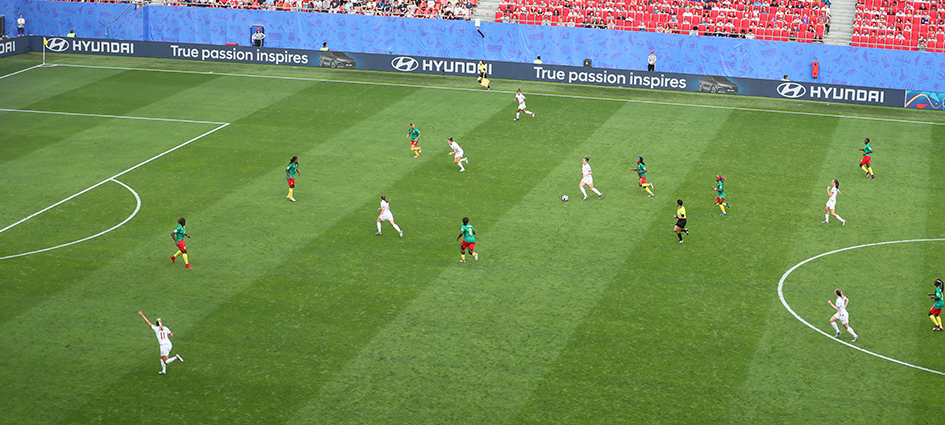Effective practice design

What is numerical superiority?
- Steve Lilley
- 28 August 2019
FA county coach developer, Steve Lilley, explores the idea of numerical superiority and what it means for grassroots coaches.
During the recent Women’s World Cup in France, England head coach, Phil Neville, talked about the importance of numerical superiority to his team’s playing style.
Neville outlined how the Lionesses tried to create numerical superiority in central areas of the pitch through wide players drifting inside and central midfield players dropping into deeper areas. By creating overloads in central areas opportunities were made to play through the opposition and exploit the spaces created.
In this article I will try to explore the idea of numerical superiority when in possession of the ball in more detail and look at what the numerical superiority might mean to coaches and players in the grassroots game.
What is numerical superiority?
Numerical superiority refers to the number of players in a given zone or space in comparison to that of the opposition – for example four attacking players versus three opponents. If a team has numerical superiority and possession of the ball, there is the opportunity to create an overload situation and exploit the opposition.
Why is numerical superiority important?
Numerical superiority can help a team secure the ball, dominate possession and/or penetrate the opposition. Although there are many benefits to numerical superiority in possession it can, however, leave other players exposed to 1v1 or 2v1 situations if the ball is lost and transition takes place.

Where does it happen?
Numerical superiority can occur anywhere on the pitch, but often happens naturally in the defensive unit of a team when playing out from the back. Goalkeepers now play a much more prominent role when a team is in possession and are integral to building an attack through overloads.
In this scenario, opponents often prioritise the protection of their own goal rather than committing players forward to press. This allows the team playing out from the back numerical superiority. A team’s playing style, out of possession philosophy and the state of the game will have an impact on this.
Due to the defensive arrangements of many teams, numerical superiority can become more difficult as the team in possession progresses up the pitch.
When does it happen?
Numerical superiority can happen whenever a team is in possession of the ball and is linked to the team playing style, game plan and state of the game.
Often a team will use a pre-determined ‘launch pad’ or ‘trigger’ which dictates when and where movements are made in order to create overloads in certain areas of the pitch.
For example, a team which likes to penetrate the opposition early and directly may encourage their midfield players to make forwards runs as soon as one of their defenders receives the ball.
These forward runs can be made as they know a long penetrative pass will be played to the number nine with the aim of creating numerical superiority in, around or beyond the opposition backline.
How does it happen?
Numerical superiority is often achieved through dynamic and well-timed movement. These movements involve players coming off their shape, either with or without the ball. Fluid rotations and the interchanging of positions are also important, as is the exploitation of space created by teammates or vacated by opponents.
My interpretation of the principles of play for this specific focus is as follows:
- The movement of players to create space and ultimately support each other
- Creating overloads with the aim of penetrating the opposition
- Creativity in order to both create and exploit the space
Who is involved?
The diagrams below offer a number of examples of how to create numerical superiority when playing in a GK-4-2-3-1 formation. The patterns are based on playing out from the goalkeeper and through the team.
How can you work on numerical superiority in training?
It can be difficult to replicate the exact pictures and movements that occur on matchday during training sessions due to lack of space and/or number of players. However, if, as coaches, we are creative with our practice design then it is possible for players to work on such movements and transfer them to their game. See diagram below:

Task:
When working on numerical superiority in your training sessions, consider the following:
1. The format of the game your team plays: 7v7, 9v9 or 11v11
2. The formation your team plays (not forgetting the importance of the GK)
3. Your own in possession playing philosophy
4. Which areas of the pitch you would like to gain numerical superiority.
Challenge: draw up a number of ways in which numerical superiority can be achieved and devise a series of practices to help your players execute the movements involved.
All comments on this article are welcome. Please contact steve.lilley@thefa.com or @SteveLilley4 on Twitter.
This article is based on a presentation at the 2019 United Soccer Coaches Convention.



























